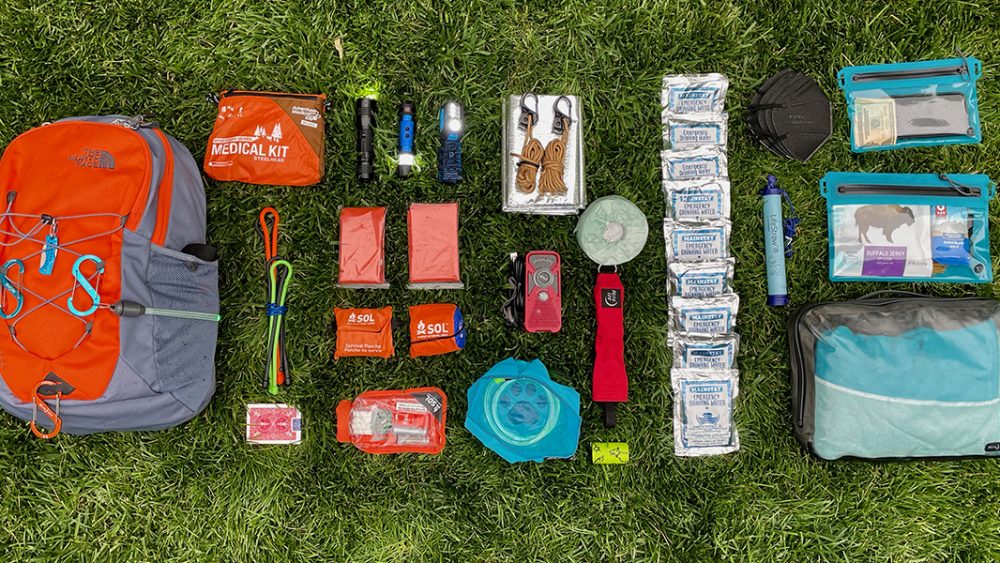This week’s fires are a chilling reminder that emergencies can strike without warning, whether due to natural disasters, power outages, or unexpected crises. One of the most effective ways to stay safe and be ready for the unexpected is by having a Go-Bag — a portable emergency kit filled with essential supplies that can sustain you and your family for at least 72 hours. Here’s what you should include to be prepared for any situation. Taking the time to have a go-bag ready before you are in a crisis situation allows you the time and clarity to be prepared and not left to make preparations under extreme circumstances and stress.
Go-Bag Basics
A Go-Bag is typically a backpack or duffle bag that contains all the essentials you’ll need in case of an evacuation or an emergency situation. Its contents should be compact, organized, and easily accessible.
Essential Items to Include
- Three-Day Supply of Non-Perishable Food and Water – Pack enough food for each person in your household to last at least three days. Choose items that require no refrigeration, cooking, or special preparation, such as canned goods, energy bars, and dried fruits. You’ll also need three gallons of water per person for drinking and hygiene.
- Map with Evacuation Routes – In case of evacuation, it’s vital to have a map showing multiple routes out of your area. Ensure it’s clearly marked with at least two alternative evacuation paths in case roads are blocked.
- Prescriptions or Special Medications – If you or someone in your family takes prescription medications, be sure to pack an extra supply, along with a copy of the prescription, in case of delays or difficulty in refilling your medications.
- Change of Clothing – Pack at least one complete change of clothes for each person, including underwear, socks, and sturdy shoes. Opt for weather-appropriate clothing and a lightweight jacket or blanket.
- Extra Eyeglasses or Contact Lenses – If you wear glasses or contacts, pack an extra pair, along with the necessary solution or storage case, to avoid complications during an emergency.
- Extra Car Keys, Credit Cards, Cash, or Traveler’s Checks – Ensure you have an extra set of car keys in case you need to leave your vehicle behind. Include cash or traveler’s checks since ATMs and credit card systems may be unavailable during a crisis.
- First Aid Kit – A well-stocked first aid kit is essential for treating minor injuries. Include bandages, antiseptic wipes, gauze, adhesive tape, tweezers, and pain relievers.
- Flashlight and Extra Batteries – Power outages are common during emergencies, so having a reliable flashlight is crucial. Make sure to pack extra batteries to keep it functioning.
- Battery-Powered Radio – A battery-powered or hand-crank radio will help you stay updated with emergency alerts, weather reports, and evacuation instructions, especially if the power goes out.
- Sanitation Supplies – Hygiene is important in an emergency situation. Include items like wet wipes, hand sanitizer, toilet paper, and garbage bags for waste disposal.
- Copies of Important Documents – Keep copies of important documents such as birth certificates, passports, insurance papers, and medical records in a waterproof container. This ensures you’ll have access to critical information even if you’re forced to evacuate.
- Pet Food and Water – Don’t forget your furry friends! Pack enough pet food and water to last for several days, along with a leash, collar, and any medications they may need.
Emergencies are often unpredictable, but with a Go-Bag packed with the essentials, you can be ready to face a crisis with confidence. Regularly review and update your Go-Bag, ensuring that all supplies are in good condition and still relevant to your needs. A little preparation can go a long way in ensuring the safety and well-being of you and your loved ones during an emergency.
Photo credit and link to some essentials – https://niteize.com/blog/15-essentials-for-your-emergency-go-bag/




